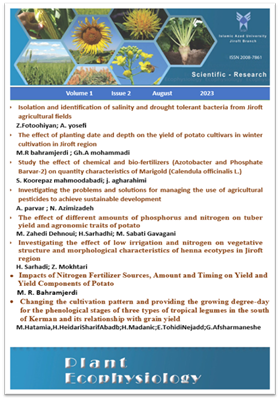Isolation and identification of salinity and drought tolerant bacteria from Jiroft agricultural fields
Subject Areas : Journal of plant ecophysiologyزینب فتوحیان 1 * , احمد یوسفی 2
1 - گروه آسیب شناسی گیاهی، واحد جیرفت، دانشگاه آزاد اسلامی، جیرفت، ایران
2 - گروه میکروبیولوژی، واحد جیرفت، دانشگاه آزاد اسلامی، جیرفت، ایران
Keywords: identification, Jiroft, drought, Resistant bacteria and Salinity,
Abstract :
Due to the increasing spread of dry lands in different regions of the world, including Iran, it should be adapted to the new conditions and there must be a plan to prevent the development of these lands. Due to the fact that some areas of Jiroft city were affected by drought and salinity facoers, therefore they were considered in this study. One of the new ways to cope with salinity in plants and reduce its harmful effects is to introduce salt-tolerant bacteria. In this research, indigenous bacteria resistant to salinity and drought were isolated and identified. The growth rate of isolates at different concentrations of salinity (5%, 10%, 15%, 20%, 25%, 35% and 40%), drought(0.50, -0.15, -0.03, -0.49 and -0.73 MPa), pH and temperature of 50°C was calculated by reading the optical absorption by spectrophotometer. Then, the production of auxin, siderophore and hydrogen cyanide and phosphate solubility of resistant isolates were investigated. A total of 42 soil samples were collected from the salty and dry areas of Jiroft city in the crop year 2019 and of this number of soil amples, 50 bacteria were obtained. From isolates, K4, K10, K12, K14, K15 codes for the Konar-sandal, C18, C10, C11codes for Karim-abad, A2, A3, A4 codes for anbar-abad were resistant to salinity due to their growth up to 40% salt concentration. Also, the K4, K14, K15, and C8 codes had the ability to grow in water potential at -0.73 and resistant to drought. From selective isolates, the isolate C8 had the ability to grow at high pH and C8 and K4 isolates were capable of growing at 50°C. Also, isolate C8 produced the highest amount of auxin among isolates by producing 1.8 μg/ml of auxin and it was the only isolate that dissolved phosphate. The isolates C8 and K14 had the ability to produce cidrofur in isolates. Therefore, according to biochemical and molecular identification of isolate C8, it was Bacillus subtilis as the superior isolate. This isolate was isolated from the Karim-abad region.

